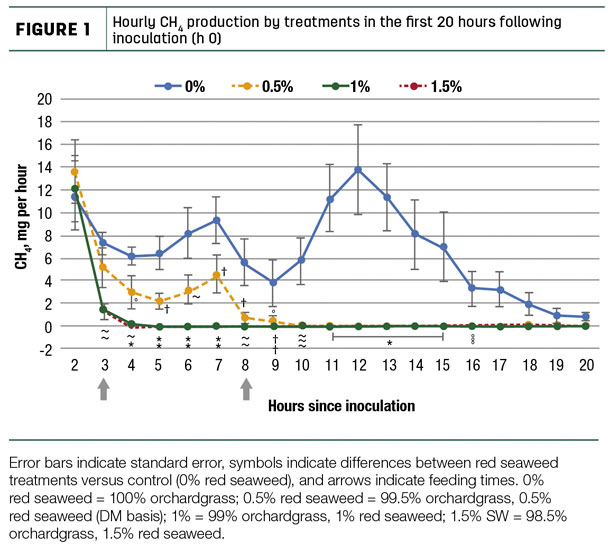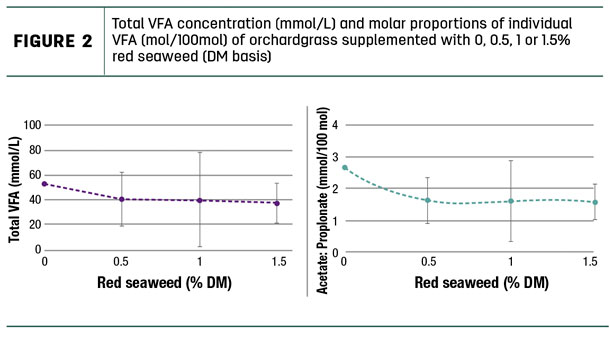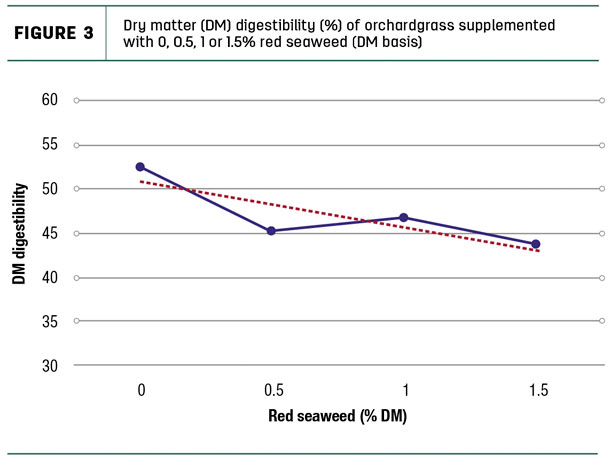Historically, dairy and beef producers have been focused on maximizing animal outputs. This has been achieved through the adoption of new management systems, improved animal and crop genetics, and large-scale mechanization and automation of operations. However, new challenges face the 21st century producer.
At the forefront is the modern farmer’s role in helping reduce greenhouse gas emissions without sacrificing production efficiency. Dairy and beef production contribute substantial quantities of methane (CH4) to the atmosphere every day due to the rumen fermentation process.
Greater amounts of enteric (from the rumen) CH4 emissions signify reduced feed efficiency, which in turn may result in decreased animal productivity (growth, milk). This is compounded under grazing operations, as greater proportions of forage can increase CH4 emissions due to more fiber in the diet. Therefore, finding a solution to reducing CH4 emissions from grazing ruminants is of critical importance.
Seaweed may provide a potential solution to decreasing CH4 emissions from grazing ruminants. Red seaweed contains bioactive compounds, specifically bromoform, that limit activity of CH4-producing microbes in the rumen. However, too much seaweed in the diet may lead to negative effects on livestock performance and productivity.
Several laboratory tests from Australia found that small amounts – less than 2% dietary dry matter (DM) inclusion – reduced CH4 emissions by up to 99%. These trials also showed no negative effect on digestibility, which implies that animal production would not be negatively impacted. However, this red seaweed was not tested using forages common in temperate regions of the U.S.
We conducted a laboratory test to examine the effect of red seaweed (Asparagopsis taxiformis) on CH4 production and nutrient digestibility at the USDA-ARS Pasture Systems and Watershed Management Research Unit.
Red seaweed was included at four rates (zero percent, 0.5%, 1% and 1.5% DM) to an orchardgrass pasture diet. Four fermentation vessels were inoculated with rumen fluid from a donor cow and monitored for CH4 as well as indicators of nutrient digestibility and products of fermentation [e.g., volatile fatty acids (VFA) and pH].
All levels of red seaweed, even the lowest dose of 0.5%, caused an almost immediate reduction in CH4 production (Figure 1).

The zero percent red seaweed control diet maintained steady CH4 production. Conversely, all diets supplemented with red seaweed nearly eliminated CH4 production within five to 12 hours after first feeding and never produced any quantifiable amounts of CH4 after reaching zero CH4 on day one.
This suggests that the potency of our red seaweed material was quite strong, as we achieved almost complete reduction of CH4 at about one-quarter of the rate previously reported to cause similar reductions in CH4.
In general, total VFA levels decreased with each increasing level of red seaweed inclusion (Figure 2).

This decrease is concerning as the three primary VFAs (acetate, propionate and butyrate) serve as the main sources of energy for ruminants and may have negative implications on milk production or average daily gains (ADG).
There were also changes in the proportion of individual VFAs, with the ratio of acetate to propionate decreasing with the inclusion of any level of red seaweed. This was driven by decreases in acetate rather than an increase in propionate. Generally, forage-based diets strongly favor acetate production, which results in more CH4 production but greater amounts of milkfat.
Feed digestibility decreased with increasing levels of red seaweed (Figure 3).

This suggests that even small amounts of red seaweed can potentially reduce animal ability to digest nutrients for growth and milk production. However, previous research has only shown these results at larger feeding rates (greater than 2% red seaweed) and effectively reduced CH4 production at lower levels of inclusion than what we tested (less than 0.5%). This suggests proper dosing is required to balance CH4 suppression with digestibility and reiterates the point that potency is a major factor in red seaweed effectiveness.
The primary factor driving the potency of our red seaweed was most likely bromoform concentration. Bromoform occurs naturally in red seaweed and has been shown to impair CH4-producing microbes in the rumen.
Concentrations of bromoform in the red seaweed material used in different studies is highly variable, usually ranging from zero percent to 1%. The concentration of bromoform used in our research was at the high end of that spectrum, which likely accounted for the rapid reduction of CH4. The decreased levels of VFAs and acetate were likely a product of reduced digestibility, as this would limit the amount of VFAs produced by rumen microbes.
While our study found reductions in forage digestibility, other studies have examined red seaweed with lower concentrations of bromoform and found little to no effect on feed digestibility. Our results were likely due to the greater bromoform concentrations of the red seaweed. If red seaweed bromoform levels are high, forage-based diets can be supplemented with high-digestibility feedstuffs in the form of grain, silage, brassicas or other leafy species to offset some of this loss of digestibility.
There is also evidence that even lower rates of red seaweed could be fed, which would achieve the same CH4 abatement while reducing the risk to VFA production and digestibility.
This study provided an initial understanding of the benefits and risks associated with supplementing forage-based diets with small amounts of a specific red seaweed. Our findings indicated that dietary inclusion of less than 1% red seaweed caused immediate and substantial reductions in the quantity of CH4 production, resulting in negligible CH4 within half a day.
This is very promising from an economic standpoint, as red seaweed is very expensive (about $75 per pound) due to low supply and intensive post-harvest handling procedures. Red seaweed also has a short shelf life, with bromoform deteriorating under ultraviolet light or warm temperatures.
Currently, red seaweed is not readily available in commercial markets here in the U.S.; several European and Australian companies are developing further processes to improve harvest and storage efficiency of the material.
Once red seaweed becomes more readily available, ensure that the vendor provides the concentration of bromoform prior to purchasing it, as greater bromoform concentrations will require less red seaweed material to mitigate CH4.
Additionally, store the material in a dark, refrigerated location. This will help ensure that maximum CH4 reduction is met for the lowest amount of supplemental red seaweed material added and increase the shelf life of the product.
Correct dosing is also important, as greater rates of red seaweed inclusion negatively affected digestion of the orchardgrass feed in our trials. The effects observed in this study could potentially vary if different dietary components were used (e.g., starch-based grains). Further testing through animal feeding trials that incorporate various forage and grain-based diets will be valuable to determine the ultimate efficacy of providing supplemental red seaweed to ruminant rations.










